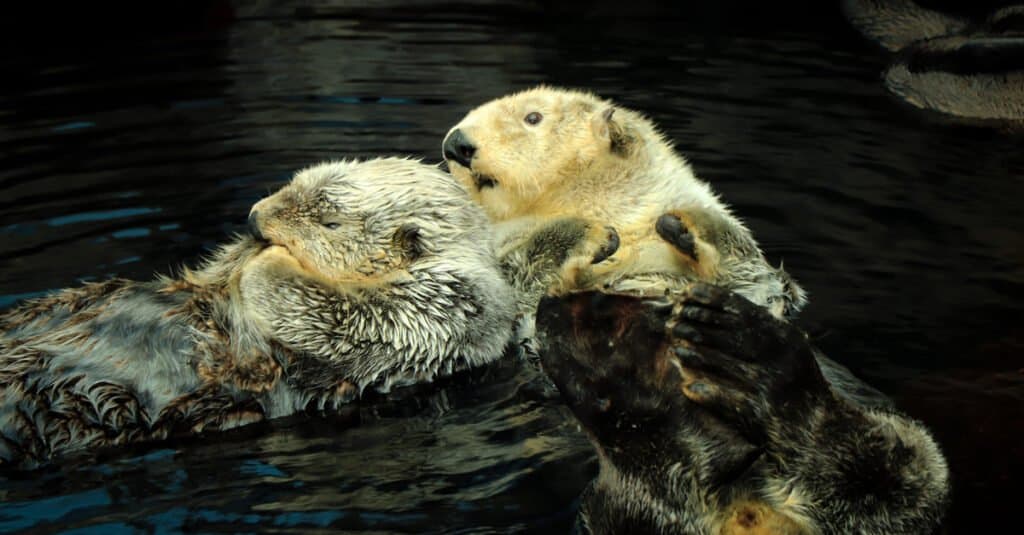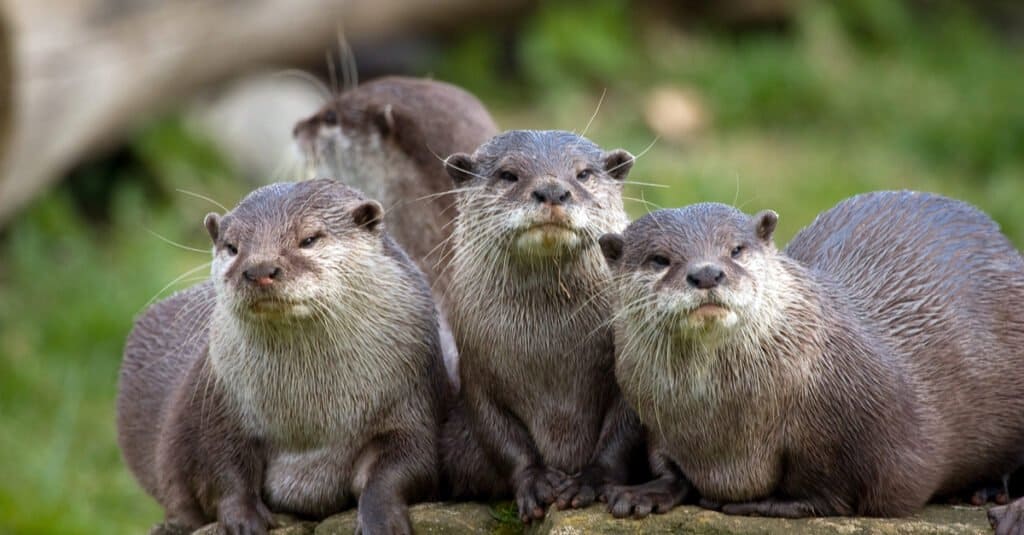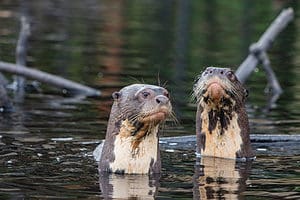Have you ever seen a picture of two otters floating in a stream while holding hands? If you have, you probably thought you were looking at a pair of otters in love.
Well, while that’s a nice thought, there’s a more practical reason behind this handholding behavior.
Check out the following information to answer the question “Why do otters hold hands?” and to determine if every type of otter displays this behavior.
Also, consider several other facts about these slippery, lovable animals that may surprise you.
Why Do Otters Hold Hands?
It turns out there are many reasons why these animals hold hands. Normally, otters hold hands while they are asleep. A pair of them may roll over onto their backs and float in the water while sleeping. They usually choose a place near the shoreline where the water is calm.
But, after heavy rain, a river can start to move fast. Even if it hasn’t rained in a while, a river is still flowing at a constant rate of speed. This puts a pair of these dozing mammals at risk of being carried downstream! Hence, otters hold hands to prevent the water current from bearing them away.
A male otter may also hold hands with a female to let other males know that she is spoken for.
Self-preservation is another reason why they hold hands while they’re asleep. Sleeping on land means they are vulnerable to hunters and predators. So, these animals sleep in the water to avoid the attention of hunters.
Males and females sometimes hold hands with one of their babies or pups, so it won’t float away while it’s resting. The pups are small and extremely vulnerable to predators. A pup’s mother has to take steps to protect it even while asleep.

©nvphoto/Shutterstock.com
Do All Otters Hold Hands?
No. Some hold hands while others don’t display this behavior. Sea otters spend most of their time in the water and hold hands while asleep. Alternatively, river otters live on land a lot of the time.
They sleep on land, so they don’t have to hold hands to stay together. Instead, they snuggle together onshore while taking a snooze and getting warm in the sunlight.
What Are the Differences Between Sea Otters and River Otters?
Handholding behavior is just one feature that differentiates sea otters from river otters. Another difference relates to the size of these creatures. A male sea otter weighs as much as 90 pounds! On the other hand, a male river otter weighs no more than 30 pounds full grown.
Of course, both types of otters like to swim. But river otters swim right side up with most of their body underwater. You may only see a river otter’s nose and head peeking up from the surface of the water. This type of otter uses its four webbed feet to move through the water with speed.
In contrast, sea otters like to flip over on their backs and float. They travel through the water using their webbed hind feet and tail. Because it only has two webbed feet instead of four, a sea otter doesn’t swim as efficiently as a river otter.
Both of these animals are expert divers. But which one dives the deepest? The answer is the sea otter. These otters can dive hundreds of feet into the water. Their ears and nostrils automatically close up when they dive so they don’t fill up with water. Furthermore, they can stay under the surface of the water for five minutes and sometimes longer.
River otters dive to a depth of about 60 feet and can stay underwater for 8 minutes without taking a breath.
The ability to remain under the surface of the water for several minutes gives these animals the chance to find food. Both of them are carnivores. The sea otter eats snails, fish, sea urchins, and squid. The river otter consumes fish, crayfish, crabs, and frogs.
While both animals have thick fur to keep them insulated in cold water, the sea otter’s coat is much thicker than a river otter’s coat. There’s a little difference in the color of the coats of these two animals. A sea otter’s coat is dark brown while a river otter’s fur is usually brown or gray.
The main difference to remember about these two otters is the sea otter spends most of its time in the water while the river otter is on land the bulk of the time.

©o0swfh0o/Shutterstock.com
What Are the Predators of Otters?
Predators of the sea otter are coyotes, bald eagles, great white sharks, killer whales, and California sea lions. The predators of a river otter include alligators, bobcats, eagles, and coyotes. As you see, these otters have some different types of predators due to their habitats.
Otter pups or young otters are more vulnerable to predators than adults. Interestingly, pups have fur that is so thick that they are not able to dive under the surface of the water. They will only be able to do this when they grow their adult coat of fur.
Diving is another way to escape from predators.
Do Otters Have Any Defense Against Predators?
Yes. Otters have sharp teeth they can use in a struggle with a predator. Some otters snort to alert others in the area so they can take cover from a threat.
Sea otters sometimes hide from predators like sharks and whales in large areas of kelp. River otters protect themselves by going onto land and making their way to cover. River otters can run as fast as 15mph.
Additionally, sea otters have three main ways of escaping predators such as fleeing, taking refuge in kelp, and coming onto land. Some predators that otters must fight against are bobcats, coyotes, mountain lions, wolves, and black bears. Even domestic dogs can sometimes pose a threat to otters found on land.
What Are Some Other Unique Behaviors of Otters?
Otters have been known to slide down hilly shorelines ending up in the water. Adult otters may do this to escape a predator on land whereas young otters slide as a form of play.
Otters have another behavior known to biologists as sprainting. This is when an otter spreads its feces to mark its territory. Their feces known as spraint has a scent to it that lets other otters known there is a claim on the territory.
These animals dedicate a lot of their time to grooming their fur. They comb it with their toed paws to get the dirt and water-logged debris out of it. Otters may also blow into their fur to clean it.
If you see an otter rolling in the leaves or rubbing itself against the ground or on the bark of a tree, it is trying to dry its heavy coat.
Next Up…
- 10 Incredible Otter Facts – Interested in learning amazing facts about otters? Some of these facts may surprise you!
- River Otter vs Sea Otter: 5 Key Differences – What’s the differences between a river otter and a sea otter? Keep reading to learn!
- Are Otters Dangerous? – Are otters dangerous? Should you avoid them? Click here to find out!
The photo featured at the top of this post is © nvphoto/Shutterstock.com
FAQs (Frequently Asked Questions)
Are otters solitary?
Despite the handholding behavior, these animals are considered mostly solitary. Males and females come together during mating season. Also, otter pups stay with their mother for about the first six months of life. So, there are circumstances when these animals live together for a while.
Are sea otters and river otters Endangered?
One is Endangered and the other is not. The IUCN Red List of Threatened Species reports that the sea otter is Endangered with a decreasing population.
The North American river otter is listed as Least Concern with a stable population.
Why are sea otters Endangered?
Sea otters are Endangered due to oil spills. When these otters encounter an oil spill, the oil degrades the insulating layer of their coat. This makes them vulnerable to cold temperatures and causes many to die. These creatures also become trapped in commercial fishing nets and die as a result.
Why are sea otters Endangered?
Sea otters are Endangered due to oil spills. When these otters encounter an oil spill, the oil degrades the insulating layer of their coat. This makes them vulnerable to cold temperatures and causes many to die. These creatures also become trapped in commercial fishing nets and die as a result.
Are sea otters still hunted for their fur?
In the late 18th century and into the early 20th century, sea otters were hunted for their fur. These animals were hunted to make coats, hats, and other clothing. Unfortunately, this type of fashion was especially popular during that period in time. This hunting and trapping activity caused their population to decrease almost to the point of extinction. At one point there were believed to be just one to two thousand left in existence.
Today, in many places, hunting otters is outlawed. The combination of these laws and education about this animal has allowed for the slow recovery of its population.
How do otters communicate with one another?
Though you may think of these animals as quiet, they have a lot of ways of talking to each other. They sometimes whistle or bark to alert other otters of danger nearby. Adult otters can also make a screaming sound when in serious danger.
Otter pups chatter and makes whining sounds to get the attention of their mother.
Thank you for reading! Have some feedback for us? Contact the AZ Animals editorial team.






